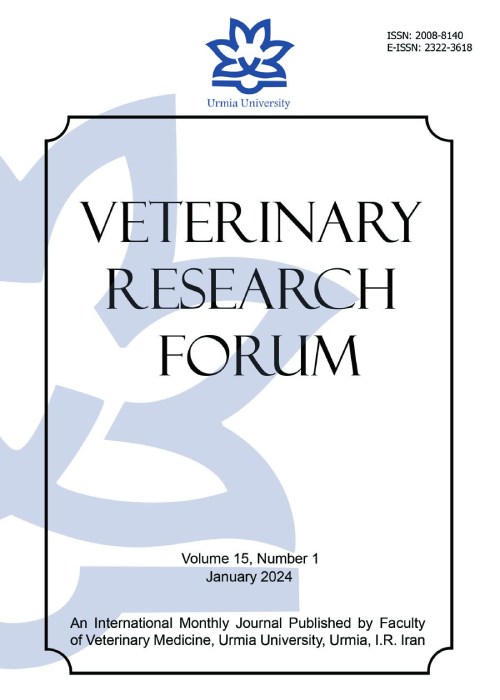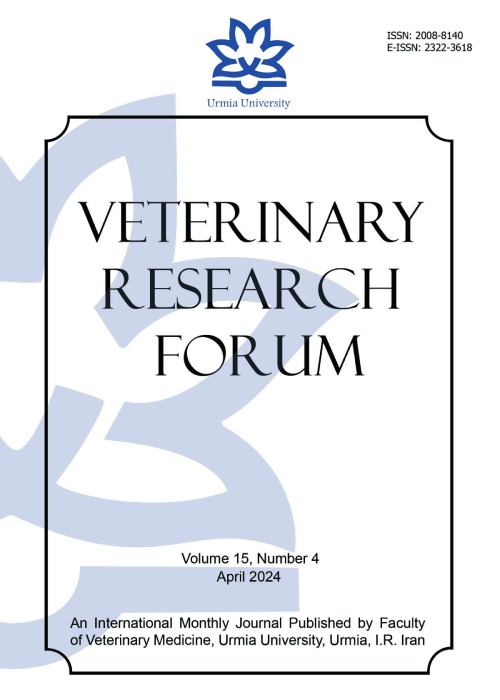فهرست مطالب

Veterinary Research Forum
Volume:15 Issue: 1, Jan 2024
- تاریخ انتشار: 1402/10/11
- تعداد عناوین: 8
-
-
Pharmacokinetic enhancement of marbofloxacin by alpha-1-monolaurin pre-treatment in broiler chickensPages 1-6The present study investigated the prospect of improvement in pharmacokinetic (PK) parameters of marbofloxacin due to alpha-1-monolaurin pre-treatment in broiler chickens. Two groups of broilers were administered a single oral dose of marbofloxacin (5.00 mg kg-1 body weight): Group-I without pre-treatment and Group-II with alpha-1-monolaurin pre-treatment (4.00 g kg-1 feed for 10 days). Blood sampling was done periodically for both groups and plasma marbofloxacin concentrations were determined using ultra-high performance liquid chromatography. Pharmacokinetic parameters using non-compartmental modelling approach were calculated with the PKSolver software. Statistical analysis revealed significant differences in plasma marbofloxacin concentrations between the two groups at 1, 2, and 24 hr. Group-II birds exhibited a higher mean maximum plasma concentration (2.43 µg mL-1) at an earlier time (Tmax: 1.38 hr) compared to Group-I. The plasma concentrations of marbofloxacin were maintained above 0.10 and 0.18 µg mL-1 up to 24 hr in Group-I and Group-II broilers, respectively. Significant differences were observed in PK parameters such as the area under the curve and total body clearance. The mean relative oral bioavailability of Group-II birds compared to Group-I was 119.61%. The findings of the study provided evidence of PK parameters enhancement of marbofloxacin in the alpha-1-monolaurin pre-treated group. The calculated PK-pharmacodynamic indices for marbofloxacin predicted clinical efficaciousness in the broiler chickens.Keywords: Alpha-1-monolaurin, Broiler chickens, Marbofloxacin, Oral pharmacokinetics
-
Pages 7-12Mycoplasma synoviae, which causes the disease known as chicken synovitis, causes serious immunosuppression. We developed a rapid insulated isothermal polymerase chain reaction (iiPCR) assay for on-site detection of M. synoviae using a primer and probe set targeting the variable lipoprotein and haemagglutinin (vlhA) gene. In addition, the specificity, sensitivity, repeatability, and clinical detection of this method were evaluated. Our iiPCR assay detected M. synoviae clinical isolates and samples successfully and produced negative results on Mycoplasma galliscepticum, avian viral arthritis, Escherichia coli, Salmonella, Staphylococcus aureus and Corynebacterium, indicating that the PCR reactions were specific. Additionally, our iiPCR assay detected the prepared positive standard plasmid diluted 10 times (1.00 × 10-1 - 1.00 × 10-10) as a template. The undiluted positive plasmid was positive and double distilled water was negative indicating that the PCR reactions were sensitive, respectively. Finally, the vlhA positive standard plasmid with dilution multiple of 1.00 × 10-4 - 1.00 × 10-6 was repeatedly detected three times to evaluate the repeatability of the iiPCR method established in this experiment showing that the iiPCR of M. synoviae is repeatable. The established iiPCR was also used to detect 50 chicken joint enlargement samples. The thermostatic detection PCR established in this experiment was comparable to a reference real-time PCR (qPCR).Keywords: Insulated isothermal PCR, Mycoplasma synoviae, on-site detection
-
Pages 13-19Viral and bacterial gastroenteritis and diarrhea have long been a problem in livestock with devastating effects on animal health and production causing a heavy financial burden on producers. Therefore, the bead-based multiplex detection assay was created for simultaneous detection of three livestock viral diarrheic agents viz. bovine rotavirus (BRV), bovine coronavirus (BCoV) and bluetongue virus (BTV). The primers and probes for triplex MAGPIX assay for simultaneous detection of three enteric viruses were designed and the assay was optimized for hybridization temperature, primer-probe and bead concentrations. The newly developed MAGPIX assay was used to determine the prevalence of these diarrhea-associated viruses by testing 200 fecal samples collected from Haryana state of India during 2018-2019. The limit of detection of the developed triplex assay was 1 × 105, 1 × 104, and 1 × 105 RNA copies for BRV, BCoV, and BTV, respectively, being lower than the reverse transcription-quantitative polymerase chain reaction (RT-qPCR). However, it was higher than the conventional RT-PCR, showing it to be more sensitive. The newly developed MAGPIX assay was a rapid, cost-effective and high throughput diagnostic tool for identification of three major entero-pathogenic diarrhea associated viruses, either alone or in tandem, with the aim to prevent and control viral diarrhea in animals.Keywords: Bluetongue virus, Bovine coronavirus, Enteric viruses, Luminex assay, Rotavirus
-
Pages 21-26The aim of this study was to compare the sedative and cardiovascular effects of the combination of acepromazine-clonidine versus acepromazine-xylazine in horses. Four healthy cross-bred horses were included in the study. They were assigned to two treatments. In treatment I (T1), the animals received xylazine hydrochloride (1.00 mg kg-1) in combination with acepromazine maleate (0.05 mg kg-1) intravenously (IV). In treatment II (T2), the animals received intra-gastric administration of clonidine (0.002 mg kg-1) followed by acepromazine (0.05 mg kg-1; IV) after 60 min. Head height above the ground (HHAG) and echocardiographic indices were evaluated. In T1, recordings were made 5 min before and 5, 15, 30, 60, and 90 min after drug administration. In T2, recordings were made 5 min before clonidine, 55 min after clonidine administration, and then 5, 15, 30, 60, and 90 min after acepromazine injection. Analyses of the data showed there were not significant differences regarding HHAG and echo-cardiographic indices between two treatments. For sedation of healthy horses, it was concluded that intra-gastric administration of clonidine and IV administration of acepromazine showed similar sedative and cardiovascular effects compared to IV acepromazine-xylazine administration.Keywords: Acepromazine, Clonidine, Echocardiography, Sedation, Xylazine
-
Pages 27-34
Spinal cord injury (SCI) presents challenging and unpredictable neurological recovery. During inflammatory conditions, the amount of serum albumin and nutrition consumption decreases. Currently, it is proposed to measure serum albumin and glucose content in human or animal subjects to predict the recovery rate and the efficiency of treatments following SCI. In this study, the effect of extra-cellular vesicles (EVs) from immortalized human adipose tissue-derived mesenchymal stem cells (hTERT-MSCs) equipped with the ectopic expression of the human indoleamine 2,3-dioxygenase-1 (IDO1) gene on serum albumin and glucose levels was investigated. After pre-clearing steps of 72-hr conditioned media, small EVs (sEVs) were isolated based on the ultra-filtration method. They were encapsulated with a chitosan-based hydrogel. Five experimental groups (female rats, N = 30, ~ 230 g) were considered, including SCI, sham, hydrogel, control green fluorescent protein (GFP)-EVs and IDO1-EVs. The 60.00 µL of hydrogel or hydrogels containing 100 µg sEVs from GFP or IDO1-EVs were locally injected immediately after SCI (laminectomy of the T10 vertebra and clip compression). After 8 weeks, non-fasting serum glucose and albumin levels were measured. The results indicated that the level of serum albumin in the animals received IDO1-EVs (3.52 ± 0.04) was increased in comparison with the SCI group (3.00 ± 0.94). Also, these animals indicated higher glucose levels in their serum (250.17 ± 69.61) in comparison with SCI ones (214 ± 45.34). Although these changes were not statistically significant, they could be considered as evidence for the beneficial effects of IDO1-EVs administration in the context of SCI to reduce hypoalbuminemia and improve energy consumption. More detailed experiments are required to confirm these results.
Keywords: Extra-cellular vesicles, Glucose, Hypoalbunemia, Indoleamine 2, 3-dioxygenase-1, Spinal Cord Injury -
Pages 35-41Neuroprotective effects for natural products are supported by several studies. In this regard, safranal, a constitute of saffron, has the potential to exert beneficial effects in neurological disorders such as Parkinson's disease, epilepsy, stroke, multiple sclerosis and Alzheimer's disease. Here, we investigated the effect of safranal on penicillin-induced epileptiform activity. Also, the effects of intracerebroventricular (ICV) microinjection of AM251 as a CB1-cannabinoid receptors antagonist to clarify the possible mechanism of safranal were evaluated. Epileptiform activity was induced by intra-cortical administration of penicillin (300 IU, 1.50 μL) in urethane-anesthetized rats. Electrocorticographic recordings were used to analyze the frequency and amplitude of spike waves. Intraperitoneal injections of safranal at doses of 1.00 and 4.00 mg kg-1 significantly reduced both the number and amplitude of spike waves. The ICV microinjection of AM251 (0.50 μg 2.00 μL-1) significantly increased the frequency and amplitude of spike waves. In addition, the anti-epileptic effect induced by administration of safranal at a dose of 4.00 mg kg-1 was partially prevented by ICV microinjection of 0.50 μg 2.00 μL-1 of AM251. The results showed anti-epileptiform activities for safranal. Central CB1 cannabinergic receptors might be involved in the anti-epileptiform activity of safranal.Keywords: AM251, epileptiform activity, Penicillin, Rat, Safranal
-
Pages 43-47The Turkmen horse is one of the oldest breeds in the world with unique characteristics in agility, endurance and jump, being publicly acclaimed. Laminitis affects the limbs and decreases athletic performance. Radiographic evaluation is essential to confirm the sinking diagnosis in every breed of a horse suffering from laminitis. Since no information about distal phalanx radiographic measurements in this breed has been reported, the current study was designed and conducted. In the present study, 24 clinically sound registered Turkmen horses of both sexes (15 mares and nine stallions) were selected. Lateromedial radiographic views of both front distal phalanges were taken, focusing on the distal phalanx. After magnification correction, images were used to measure founder distances (FD) and other distal phalanx radiographic measurements using an image processing program. There was no significant difference between radiographic measurements of the left and right front feet. The FD had a significant positive correlation with weight. The horses under 3 years of age had a significantly greater U angle than the horses over the age of three. Also, palmarocortical length (PCL) in the Turkmen stallions was significantly higher than mares. In this investigation, PCL in horses under the age of three was significantly lower than horses over 3 years of age. The values determined in this study can be used as baseline data of front feet in Turkmen horses.Keywords: Distal phalanx, Forelimb, Normal parameters, Radiology, Turkmen horses
-
Pages 49-55
Purification is an important step in the production of viral vaccines that strongly affects product recovery and subsequent immune responses. The present study was carried out with the aim of improving the purification of infectious bursal disease virus (IBDV) by the tangential flow filtration (TFF) method. Then, the effect of the purified virus on the induction of immune responses against IBDV in specific pathogen free (SPF) chickens was investigated. The IBD07IR strain was propagated in embryonated SPF eggs. The virus was purified using a 100 kDa cassette. The quality of the recovered viruses was evaluated by titration. A total number of 60 SPF chickens were randomly divided into three groups (n = 20) and received the concentrated viral antigen, commercial live IBDV vaccine and phosphate-buffered saline at the age of 3 weeks by eye drop method. The bursa of Fabricius was examined histopathologically for possible changes. Sera were collected at 1-week intervals from day 0 until the end of 6 weeks after vaccination. The IBDV-specific antibody levels, induction of cell-mediated immunity and mRNA expression levels of cytokines were evaluated. The results showed that despite a relative raise in virus titer from 7.66 to 8.17 embryo infectious dose (EID)50 mL-1 following purification, both the purified IBDV and commercial vaccine are able to induce strong immune responses against the virus. Within a context of egg-based IBDV vaccine production, a single-step TFF can be applied for the relatively purification. This platform requires a further study in the selection of multiple membranes to optimize the operating conditions and final product.
Keywords: Immune response, Infectious bursal disease virus, tangential flow filtration, Vaccine


